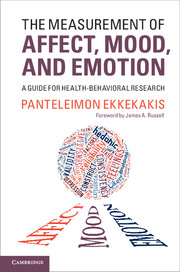Book contents
- Frontmatter
- Contents
- Figures
- Foreword
- Prologue
- 1 Documenting the breadth and depth of the problem
- 2 Untangling the terminological Gordian knot
- 3 Should affective states be considered as distinct entities or as positioned along dimensions?
- 4 Are pleasant and unpleasant states independent or polar opposites?
- 5 Selecting a measure
- 6 The old classics
- 7 Dimensional measures
- 8 Domain-specific measurement
- 9 Problems of domain specificity
- Epilogue
- References
- Index
3 - Should affective states be considered as distinct entities or as positioned along dimensions?
Published online by Cambridge University Press: 05 March 2013
- Frontmatter
- Contents
- Figures
- Foreword
- Prologue
- 1 Documenting the breadth and depth of the problem
- 2 Untangling the terminological Gordian knot
- 3 Should affective states be considered as distinct entities or as positioned along dimensions?
- 4 Are pleasant and unpleasant states independent or polar opposites?
- 5 Selecting a measure
- 6 The old classics
- 7 Dimensional measures
- 8 Domain-specific measurement
- 9 Problems of domain specificity
- Epilogue
- References
- Index
Summary
This book was based on the premise that the measurement of affective constructs, including core affect, mood, and emotion, within the domain of research investigating health behaviors would benefit from a thorough and critical reconsideration of concepts and practices. For this goal to be achieved, this domain of research must catch up to theoretical developments and contemporary measurement approaches in affective psychology. Numerous signs suggest that, over the years, certain methodological practices now shown to be either outdated or downright fallacious rose to the level of paradigm. For example, justifying the selection of a measure on the basis of the argument that “it has been used before” has appeared with such frequency in the literature that a tacit assumption must have developed that it represents an adequate or acceptable rationale. Likewise, interchanging terms or mislabeling constructs has become so common that these practices are widely emulated without eliciting criticisms from reviewers, editors, or readers.
To help overcome these problems, the previous chapter included a list of the essential features of affect, mood, and emotion that researchers can use as a guide in drawing the necessary distinctions between these constructs. Following the crucially important decision of which of these constructs should be targeted in a given investigation, the next question researchers will confront in their quest to establish a rationale for choosing a measure is how to best conceptualize or model the targeted construct (core affect, mood, or emotion). The options are many and their differences are anything but subtle. According to Russell and Feldman Barrett (1999), “some researchers use categories, some dimensions; some use bipolar concepts, some unipolar ones; some presuppose simple structure, some a circumplex, and some a hierarchy” (p. 805).
- Type
- Chapter
- Information
- The Measurement of Affect, Mood, and EmotionA Guide for Health-Behavioral Research, pp. 52 - 75Publisher: Cambridge University PressPrint publication year: 2013
- 1
- Cited by



